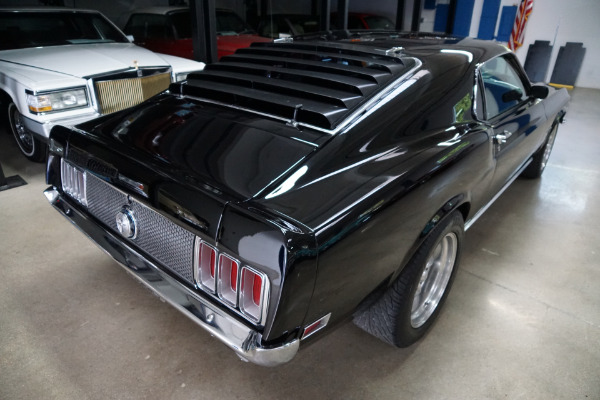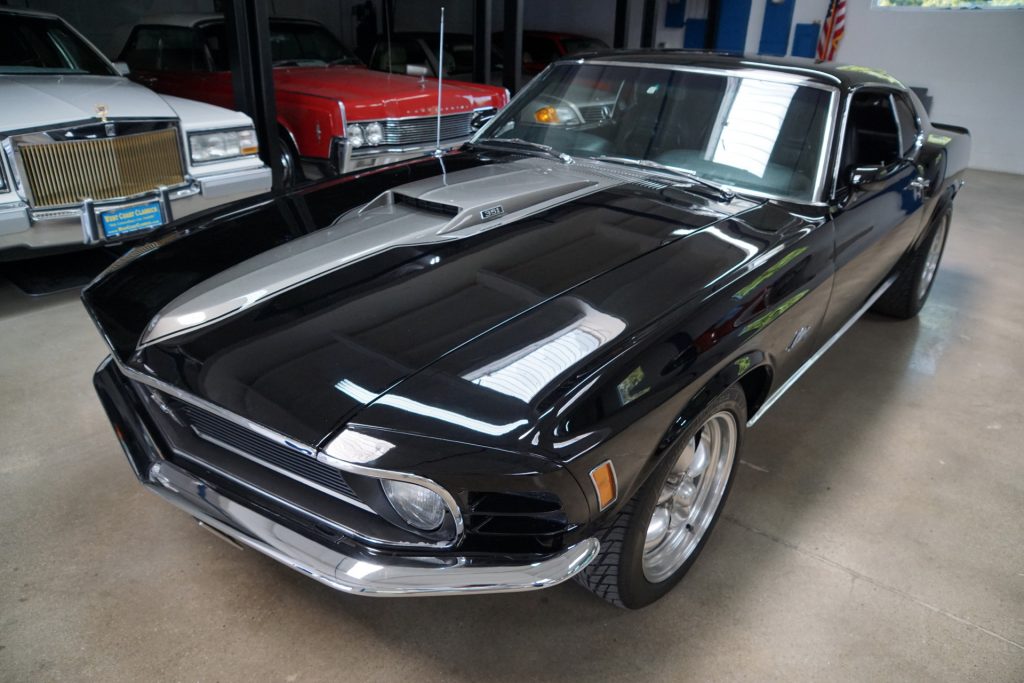Sell My Classic Car Ford Mustang 1964-1968. The classic Ford Mustang 1964-1968 is an American automobile manufactured by Ford.
It was based on the second generation platform of the North American Ford Falcon.
The Mustang created the “pony car” class of cars, sporty coupes with long hoods and short rear decks.
This lead to a string of competitors such as the Chevrolet Camaro, Plymouth Barracuda, and Dodge Challenger.
The Mustang also inspired the designs of coupes such as the Toyota Celica and Ford Capri.
Stylist Jon Najjar is credited as being the executive stylist and to have suggested the name Mustang.
The Ford Mustang was brought out five months before the normal start of the 1965 production year.
Classic Ford Mustang 1964-1968
1964 ½ Models
Early production versions are often referred to as “1964½ models” but all Mustangs were advertised, VIN coded and titled by Ford as 1965 models.
Executive stylist John Najjar, a fan of the World War II P-51 Mustang fighter plane, is credited by Ford to have suggested the name.
Najjar co-designed the first prototype of the Ford Mustang known as Ford Mustang I in 1961, working jointly with fellow Ford stylist Philip T. Clark.
The Mustang I made its formal debut at the United States Grand Prix in Watkins Glen, New York on October 7, 1962.
Test driver and contemporary Formula One race driver Dan Gurney lapped the track in a demonstration using the second “race” prototype.
Roger J. Eggert
An alternative view was that Robert J. Eggert, Ford Division market research manager, first suggested the Mustang name.
Eggert, apparently received a birthday present from his wife of the book, The Mustangs by J. Frank Dobie in 1960.
The book’s title gave him the idea of adding the “Mustang” name for Ford’s new concept car. The designer preferred Cougar or Torino, while Henry Ford II wanted T-bird II.
“Mustang,” by a wide margin, came out on top under the heading: “Suitability as Name for the Special Car.” In focus meetings.
The name could not be used in Germany as it was owned by Krupp.
Mustangs grew larger and heavier with each model year until, in response to the 1971–1973 models, Ford returned the car to its original size and concept for 1974.
The Mustang is the only original model to remain in uninterrupted production over five decades of development and revision.
Ford Mustang 1965-1973
Donald N. Frey was the chief engineer for the T-5 project
He supervised the overall development of the car in an only a year and a half.
Lacocca himself championed the project as Ford Division general manager.
The T-5 prototype was a two-seat, mid-mounted engine roadster. This vehicle used the German Ford Taunus V4 engine.
It has been said that the decision to abandon the two-seat design was in part due to the increase in sales the Thunderbird had seen when enlarged from a two-seater to a 2+2 in 1958.
Therefore the Ford Mustang was designed as:
- A four-seat car with full space for the front bucket seats
- A rear bench seat with less space than usual
Ford Mustang 1964 Fastback
A “Fastback 2+2”, first manufactured on August 17, 1964, enclosed the trunk space under a sweeping exterior line similar to the second series Corvette Sting Ray and European sports cars such as the Jaguar E-Type coupe.
Ford Mustang 1965 Fastback
The 1965 “fastback” was introduced in September 1964 for the 1965 model year
Articles appeared in 2,600 newspapers the next morning, the day the car was “officially” revealed.
A Mustang convertible also appeared in the James Bond film Goldfinger in September 1964.
The car was priced a $2,368 with many of the components such as the interior, chassis and suspension were derived for the Ford Falcon and Fairlane.
They expected to sell less than 100,000 units the first year but this figure was surpassed in 3 months.
Another 318,000 would be sold during the model year and in its first eighteen months, more than a million were built.
Mustang Upgrades
These include:
- The addition of backup lights on some models
- The introduction of alternators to replace generators,
- An upgrade of the six-cylinder engine from 170 to 120 hp (75 to 89 kW), and an upgrade of the V8 engine from 260 to 289 cu in (4.3 to 4.7 l) with an increase from 164 to 210 hp (122 to 157 kW).
The rush into production included some bizarre inclusions, such as the horn ring bearing the ‘Ford Falcon’ logo with a trim ring and a ‘Ford Mustang’ logo.
These characteristics made enough difference to warrant the designation of the 121,538 early versions as “1964½” Mustangs, a distinction that has endured with purists.
A 1969 SportsRoof
Ford’s designers began drawing up larger versions even as the original was achieving sales success, and while “Iacocca later complained about the Mustang’s growth, he did oversee the 1967 redesign.”
From 1967 until 1973, the Mustang got bigger but not necessarily more powerful.
The Mustang was facelifted, giving the Mustang a more massive look overall and allowing a big block engine to be offered for the first time.
Changes include:
- Front and rear end styling was more pronounced
- “Twin cove” instrument panel offered a thicker crash pad
- Larger gauges.
Hardtop, fastback and convertible body styles continued as before. Around this time, the Mustang was paired with a Mercury variant, called the Cougar, which used its own styling cues, such as a “cougar’s head” logo and hidden quad headlamps.
Ford 1967 Mustang
New safety regulations for 1967 included:
- Energy-absorbing steering column and wheel
- 4-way emergency flashers
- A dual-circuit hydraulic braking system
- Softer interior knobs.
Ford Mustang 1968
The 1968 models received:
- Revised side scoops
- Steering wheel
- Gasoline caps
- Side marker lights were also added that year
Ford Mustang 1968
There were improvements on the cars built after January 1, 1968, including:
- Shoulder belts for both front seats on coupes.
The 1968 models also introduced a new 302 cu in (4.9 L) V8 engine, designed with Federal emissions regulations in mind.
Ford Mustang 1969
The 1969 Mustang was restyled in certain ways:
- Width and length were again increased.
- Weight increased too.
Due to the larger body and revised front-end styling, the 1969 models (but less so in 1970) had an aggressive cut.
The 1969 models featured:
- Quad Headlamps
- Wider grille
- Standard headlamps in the 1970 models.
This switch back to standard headlamps was an attempt to tame the aggressive styling of the 1969 model, which some felt was too extreme and hurt sales, but 1969 production exceeded the 1970 total.
Models
Starting in 1969, to aid sales and continue the winning formula of the Mustang.
A variety of new performance and decorative options became available.
These included:
- Functional (and non-functional) air scoops
- Cable and pin hood tie downs
- Both wing and chin spoilers.
Performance Packages
Additionally, a variety of performance packages were introduced that included the
- Mach 1
- The Boss 302
- The Boss 429.
The two Boss models were to homologate the engines for racing.
The 1969 Mustang was the last year for the GT option (although it did return on the 3rd Generation Mustang for the 1982 Model Year).
A fourth model available only as a hardtop, the Grande, saw success starting in 1969 with its soft ride, “luxurious” trim, 55 pounds (24.9 kg) of extra sound deadening, and simulated wood trim.

A decline of the Mustang
Developed under the watch of Semon “Bunkie” Knudsen, the Mustang evolved “from speed and power” to the growing consumer demand for bigger and heavier “luxury” type designs.
The Ford Mustang became synonymous with the styling misadventures of 1971–73 and indeed grew fat and lazy or so it is said.
The cars grew in every dimension except height, and they gained about 800 pounds.
The 1971 Mustang was nearly 3 inches (76 mm) wider than 1970. Its front and rear track was also widened by 3 inches (76 mm), and its size was most evident in the SportsRoof models with its nearly flat rear roofline and cramped interior with poor visibility for the driver
Performance decreased with sales continuing to decrease as consumers switched to the smaller Pintos and Mavericks.
1964 Ford Mustang Colours
- Poppy Red
- Twilight Turquoise
- Phoenician Yellow
- Raven Black
- Pagoda Green
- Dynasty Green
- Guardsman Blue
- Caspian Blue
- Rangoon Red
- Silver Smoke Gray
- Wimbledon White
- Tropical Turquoise
- Prairie Bronze
- Cascade Greeen
- Sunlight Yellow
- Vintage Burgundy
- Skylight Blue
- Chantily Beige
- Pace Car White
1965 Ford Mustang Colours
- Poppy Red
- Twilight Turquoise
- Phoenician Yellow
- Springtime Yellow
- Raven Black
- Honey Gold
- Dynasty Green
- Arcadian Blue
- Caspian Blue
- Champagne Beige
- Rangoon Red
- Silver Smoke Grey
- Wimbledon White
- Tropical Turquoise
- Praririe Bronze
- Ivy Green
- Vintage Burgundy
- Silver Blue
- Playboy Pink
1966 Ford Mustang Colours
- Anniversary Gold
- Silver Frost
- Signal Flare Red
- Springtime Yellow
- Raven Black
- Arcadian Blue
- Sapphire Blue
- Sahara Beige
- Nightmist Blue
- Wimbledon White
- Antique Bronze
- Ivy Green
- Candy Apple Red
- Tahoe Turquoise
- Emberglo
- Vintage Burgundy
- Silver Blue
- Sauterne Gold
- Aspen Gold
- Columbine Blue
- Timberline Green
1967 Ford Mustang Colours
- Bronze
- Dark Blue
- Silver Frost
- Medium Gray
- Pebble Beige
- Springtime Yellow
- Raven Black
- Frost Turquoise
- Acapulco Blue
- Beige Mist
- Arcadian Blue
- Diamond Green
- Lime Gold
- Nightmist Blue
- Wimbledon White
- Diamond Blue
- Brittany Blue
- Dusk Rose
- Candy Apple Red
- Burnt Amber
- Clearwater Aqua
- Vintage Burgundy
- Dark Moss Green
- Sauterne Gold
- Anniversary Gold #1
- Anniversary Gold #2
- Anniversary Gold #3
- Aspen Gold
- Aspen Red
- Autumn Smoke
- Bermuda Sand
- Bluebonnet
- Brechenridge Yellow
- Columbine Blue
- Emerald Green
- Evening Orchard
- Lavender
- Limelight Green
- Loveland Green
- Metallic Purple
- Playboy Pink
- Red
- Timberline Green
- Vail Blue
- Winter Park Turquoise
- Cream
- Special Silver
1968 Ford Mustang Colours
- Raven Black
- Lime Green Metallic
- Wimbledon White
- Medium Blue Metallic
- Dark Green Metallic
- Candyapple Red
- Meadowlark Yellow
- Dark Blue Metallic
- Gold Metallic
- Orange
- Royal Maroon
- Acapulco Blue
- Gulfstream Aqua
- Lime Gold
- Wimbledon White
- Diamond Blue
- Seafoam Green
- Brittany Blue
- Highland Green
- Tahoe Turquoise
- Meadowlark Yellow
- Presidential Blue
- Sunlit Gold
- Low Gloss Black
- Pebble Beige
Selling your Ford Mustang? or want a valuation?
Then please call us today at sell a classic car, we are the no hassle way to sell any classic car including your Ford Mustang.
As a long time licensed and bonded California auto dealership, we will take care of all the paperwork for the sale of your car ….. properly take care of all the paperwork that is, with no car left still registered in your name; we will give you a fair and no BS immediate cash offer for the car; imagine no advertising costs, no dealing with “tire kickers”, no bad checks, no non-existent wire transfers, no waiting for your money and probably most importantly, no strangers at your home or in your business .. period.
We will also arrange the immediate professional pick up and transportation of your car by a licensed auto shipper from anywhere in the continental United States. Ultimately, we are one of the quickest, safest and easiest ways to sell your classic car today.
We have the knowledge and power to execute the deal immediately. So if you want some friendly advice or just a chat about how to sell us your Ford Mustang then don’t hesitate to call us at (310) 399-3990 now!

